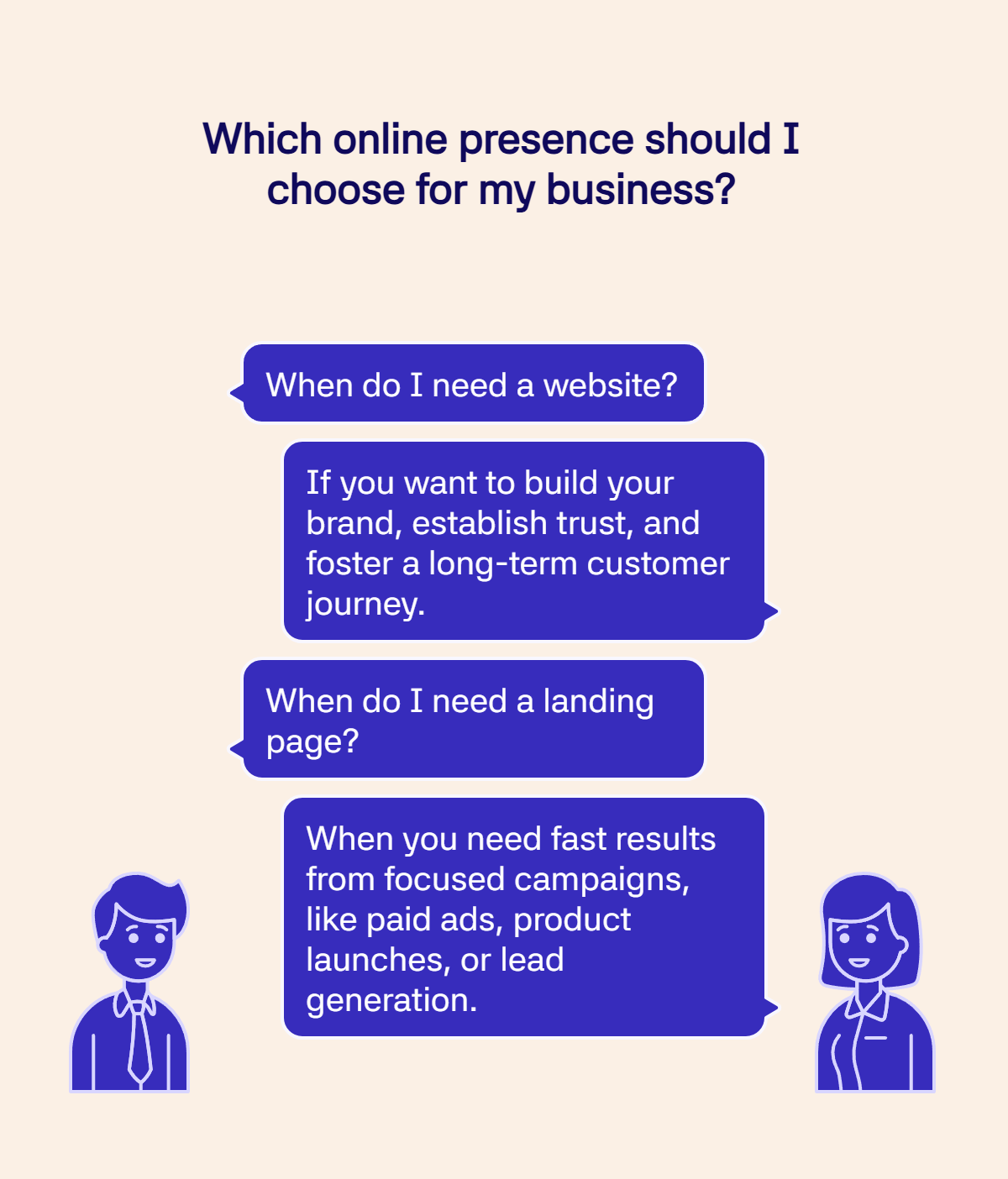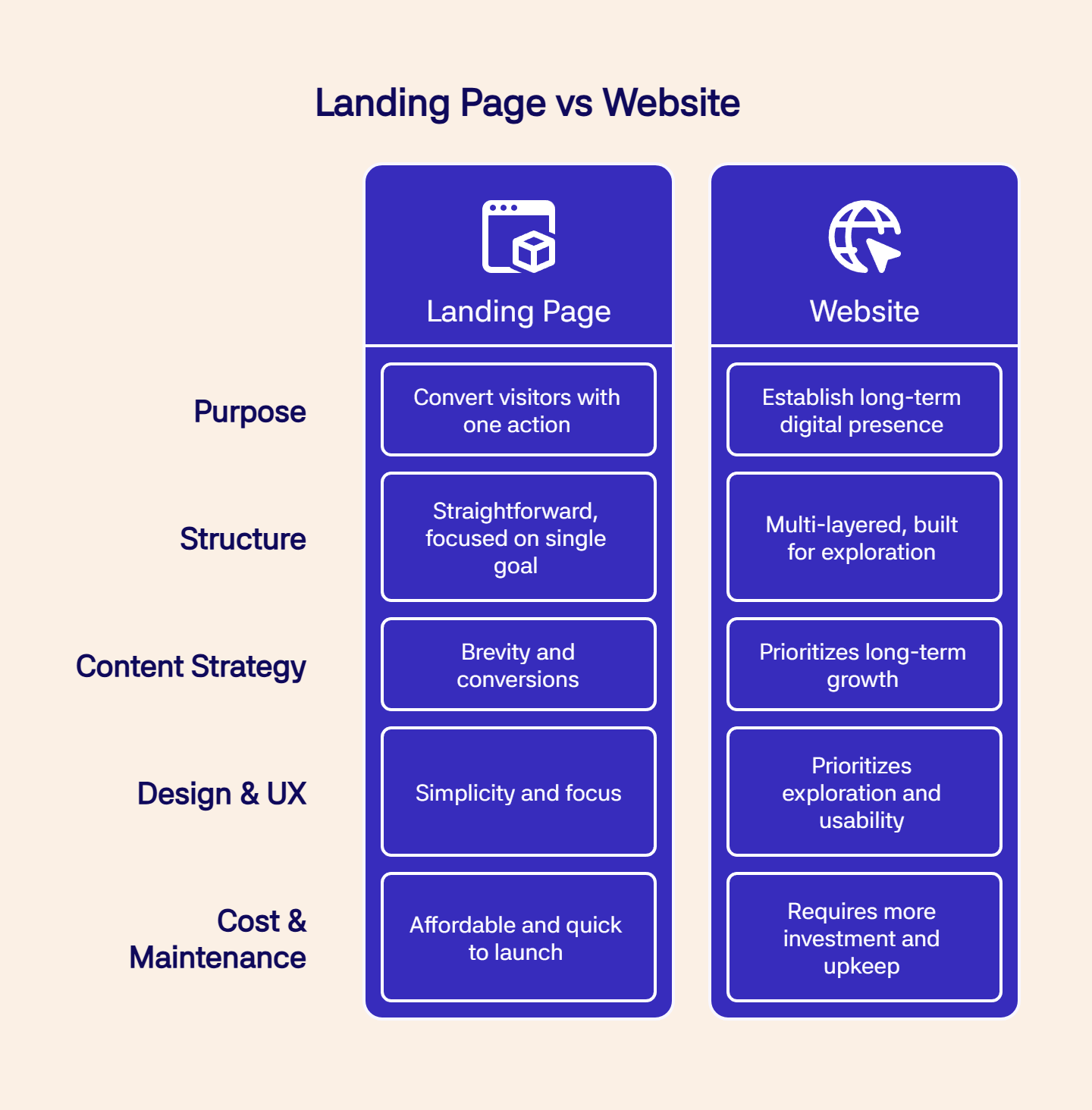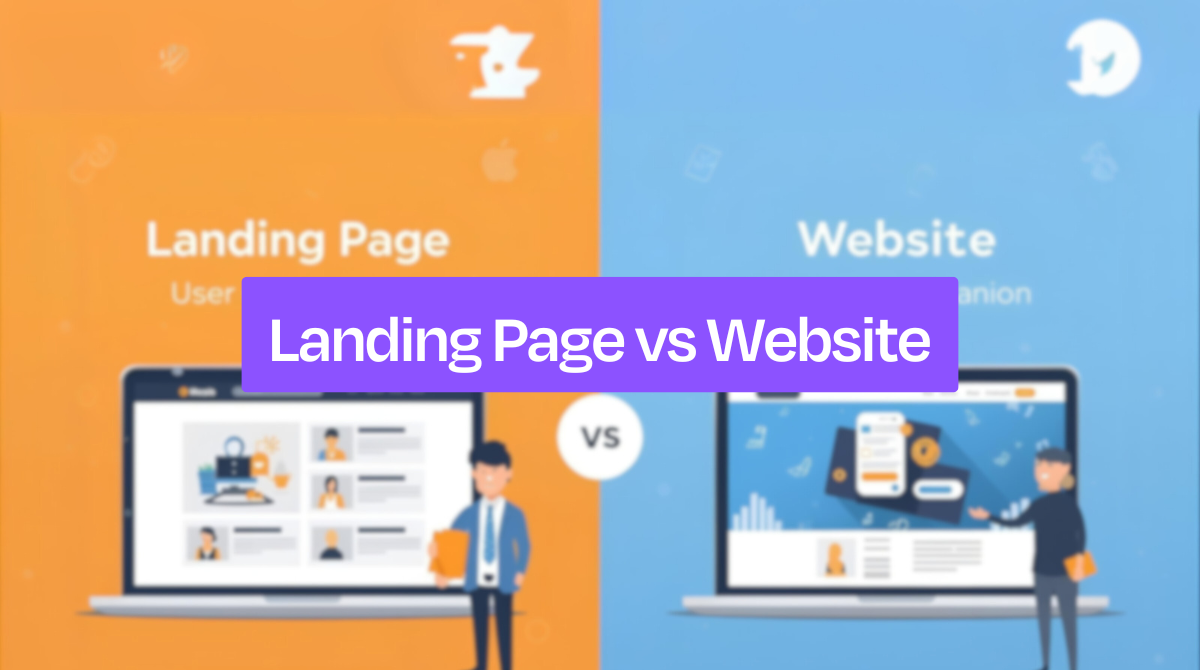The main difference between a landing page and a website is purpose. A landing page focuses on one action, such as sign-ups or sales, while a website provides a full digital presence with multiple pages for branding, SEO, and engagement. Landing pages convert quickly, and websites build long-term trust.
This guide breaks down the five key differences; purpose, structure, content, design, and cost, so you can decide which fits your goals.
Whether you need fast conversions or long-term branding, you’ll discover when to choose a landing page, a website, or both.

TL;DR:
-
Landing pages focus on single conversions while websites build a comprehensive digital presence and long-term brand authority.
-
Focused landing pages can increase conversion rates by up to 300% compared to multi-purpose website pages.
-
Smart businesses use both strategically: websites for SEO and credibility, and landing pages for targeted campaign conversions.
What is a Landing Page?
A landing page is a standalone web page designed for one specific goal, such as capturing leads, driving sales, or promoting an offer. Unlike a full website, it removes distractions and directs visitors to a single call-to-action, like sign-up, download, or purchase, making it highly conversion-focused.
Businesses use landing pages for product launches, sign-ups, free trials, or paid ad campaigns. For example, when you click on a Facebook ad for an online course, you’re often directed to a landing page that encourages you to register or buy. It’s all about conversion, not exploration.
What is a Website?
A website is a collection of connected web pages under a domain name that serves as a brand’s digital identity. It can share information, promote services, sell products, or provide entertainment. Unlike a landing page, a website offers multiple pages, richer content, and long-term authority online.
Websites generally include text, images, videos, blogs, and interactive features to help users find what they’re looking for.
So, no matter whether it’s a simple blog or a large e-commerce store, a website is your online identity where visitors learn, connect, engage, and take action.
Landing Page vs Website: 5 Core Differences
The main differences between a landing page and a website are purpose, structure, content, design, and cost. Landing pages drive one action with focused layouts and persuasive copy, while websites act as digital hubs with multiple pages, richer UX, long-term SEO, and higher investment in design and maintenance.
Here’s a quick look at five core differences that set them apart: purpose, structure, content, design, and cost.

Purpose
The purpose of a landing page is to convert visitors by focusing on one action, such as sign-ups, purchases, or downloads. Landing pages remove navigation and distractions, using persuasive copy and a single call-to-action to maximize conversions.
Studies show focused landing pages can increase conversion rates by up to 300%.
The purpose of a website, in contrast, is to establish a long-term digital presence. Websites act as a central hub with multiple pages that build authority, support SEO, and provide credibility.
They help users explore services, products, and content while creating trust and ongoing relationships, making them essential for sustainable brand growth.
Structure
The structure of a landing page is straightforward and focused on a single goal. It removes menus and extra links to guide visitors directly to one call-to-action, such as “Sign Up” or “Buy Now.” This streamlined approach keeps attention fixed on conversions.
A website’s structure, on the other hand, is multi-layered and built for exploration. It connects pages such as Home, About, Services, Blog, and Contact through navigation menus.
This design enables visitors to learn about the brand, compare offerings, and establish trust over time, ultimately strengthening websites for long-term growth and improved SEO.
Take Airbnb as an example. Its website showcases property listings, host information, community stories, and customer support. It’s a comprehensive ecosystem of pages that guides users through every stage of the journey.
Now compare that with a campaign landing page Airbnb might run for a special promotion; it would strip away extra navigation and spotlight a single goal, such as “Book your summer stay today.”
So, websites serve long-term branding and SEO, while landing pages sharpen attention on immediate conversions.
Content Strategy
Landing page content strategy focuses on brevity and conversions. Effective landing pages use sharp headlines, benefit-driven copy, testimonials, and a single call-to-action. This narrow focus reduces distractions and can lift conversion rates by over 300% compared to multi-purpose pages.
Website content strategy prioritizes long-term growth. A website leverages blogs, resource hubs, service pages, and multimedia to attract organic search traffic, educate audiences, and strengthen brand authority.
Businesses like HubSpot drive millions of monthly visits with blog-driven strategies, while campaign landing pages deliver higher short-term conversion rates.
In short, websites nurture awareness and trust, while landing pages capture leads quickly and efficiently.
Design & UX
Landing page design focuses on simplicity. Clean layouts, limited navigation, bold headlines, and one call-to-action keep users focused, with studies showing conversion rates can rise by over 30% when distractions are removed.
Websites, in contrast, prioritize exploration. They include menus, product categories, blogs, and support tools that guide users through multiple journeys.
Businesses use landing pages for campaigns that demand quick results, such as ads or product launches, where direct sales and sign-ups matter most.
Websites, in comparison, serve as digital ecosystems that nurture credibility, SEO, and long-term customer relationships. They strike a balance between design and usability, offering richer experiences without compromising brand consistency.
Cost & Maintenance
A landing page is affordable and quick to launch. Tools like Dorik AI, Unbounce, and Leadpages let businesses build conversion-focused pages for as little as $18–$99 per month.
Since a landing page is a single page with limited features, it requires minimal hosting and almost no ongoing maintenance, making it cost-effective for short campaigns or targeted promotions.
A website, on the other hand, requires more investment and long-term upkeep. Small business websites typically cost $2,000–$10,000 to design, plus monthly hosting and plugin fees of $20–$200. Regular updates for security, SEO, and content are essential.
While websites demand higher upfront and maintenance costs, they provide scalability, SEO benefits, and a lasting digital presence.
But here's the good news. You can create a fully functional website within minutes for as little as $18/month using modern no-code website builders.
Pros & Cons of Landing Page and Website
To make things super clear, here’s a side-by-side comparison of the advantages and drawbacks of landing pages and websites.
Pros of Landing Page and Website
| Landing Page | Website |
|---|---|
| Laser-focused on one goal (higher conversions) | Provides full brand presence and authority |
| Laser-focused on one goal (higher conversions) | Supports SEO with blogs, service pages, and resources |
| Quick to design and launch | Builds trust with detailed information (about, reviews, case studies) |
| Perfect for paid ads, email campaigns, and promotions | Can scale with business growth |
| Lower cost (often under $200) | Handles multiple goals at once (sales, education, support) |
| Less distracting for users | Stronger for long-term marketing strategies |
Cons of Landing Page and Website
| Landing Page Cons | Website Cons |
|---|---|
| Limited content and SEO potential | Higher upfront and maintenance costs ($2,000–$9,000+) |
| Not ideal for long-term branding | Takes longer to design and develop |
| Users can’t explore more about your business | Too much navigation can distract users from converting |
| Risk of being too “salesy” if poorly designed | Needs regular updates for security and SEO |
| — | Can feel overwhelming without a clear design flow |
When Do You Need a Website?
Use a website when your business needs a long-term digital presence that builds trust and authority. A website strengthens credibility, supports SEO campaigns, and gives visitors multiple ways to connect through blogs, service pages, and contact options. It positions your brand as reliable and discoverable online.
For example, a law firm, restaurant, or e-commerce brand can’t rely on a single page; they need full websites to share menus, case studies, or product catalogs.
Data from BrightLocal shows that 98% of consumers check online information about local businesses before engaging. It demonstrates the importance of websites for maintaining a long-term presence.
A website is also essential if you plan to run consistent SEO campaigns, educate visitors, and scale your digital marketing.
In short, choose a website if your goal is brand building, establishing trust, and fostering a long-term customer journey.
When Do You Need a Landing Page?
Use a landing page when you need fast results from focused campaigns. They work best for paid ads, product launches, lead generation, and event registrations. By removing distractions and guiding visitors to one call-to-action, landing pages achieve higher conversion rates than general website pages.
For instance, if you’re running a Facebook ad for a free ebook, sending users to a landing page with a simple form works far better than directing them to your entire site.
Landing pages are especially useful for testing offers, running A/B experiments, or customized messaging for different audiences.
In short, use a landing page when speed, focus, and conversions matter most, perfect for short-term campaigns or targeted promotions.
FAQs
Can a landing page replace a website?
A landing page can’t fully replace a website. While it’s perfect for specific campaigns or offers, it doesn’t provide the depth of information, navigation, or credibility that a website does.
Can I have both a landing page and a website?
Yes, absolutely. In fact, that’s the best setup for most businesses. Your website builds authority and trust, while landing pages help you run targeted campaigns that drive conversions. They complement each other perfectly.
How many landing pages can a website have?
There’s no limit. A website can have dozens or even hundreds of landing pages, each designed for different products, services, or campaigns. For example, an e-learning platform might have separate landing pages for each course.
Can you have a landing page without a website?
Yes, you can have a landing page without a website. Many businesses run landing pages independently, especially for ads or promotions. However, having a website adds credibility and gives visitors a way to learn more about your brand after they’ve interacted with your landing page.





